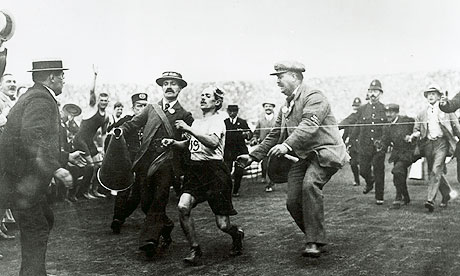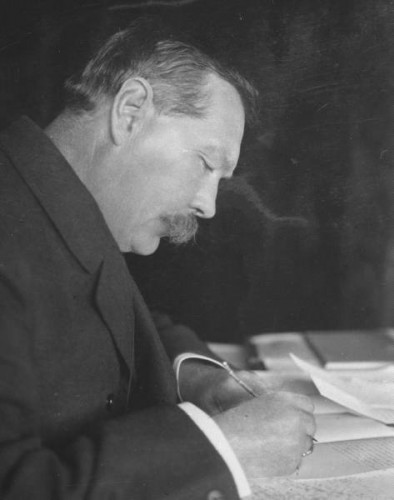The power of the sporting press when London first staged the Olympics has caused pain and blisters for runners ever since, writes STEVEN DOWNES
There’s sure to be some women in Sunday’s Olympic marathon, or runners in the men’s race later this week, who weary after the 25-mile marker or tire beyond 40-kilometres, and give a silent curse to the organisers for the apparently arbitrary extra distance that takes the race to 26 miles. And then those inexplicable 385 yards.

As they try to keep their form together over the final stages towards to finish in The Mall, they may not realise that this mystery of the marathon owes something to the creator of Sherlock Holmes.
Sir Arthur Conan Doyle, the author who devised the world’s best-known fictional detective, was a star reporter on the first London Olympic Games in 1908.
“I do not often do journalistic work,” said Sir Arthur in his memoirs, “but on the occasion of the Olympic Games of 1908, I was tempted, chiefly by the offer of an excellent seat.” Not necessarily the thoughts of sports journalists since, but one which those seated in the London Olympic Stadium this week may appreciate.
Conan Doyle’s reports from the first London Olympics did much to create the marathon myth and enshrine the long-accepted race distance.
The first Olympic marathon in 1896 – a long-distance test of endurance – was staged on the ancient road from the scene of the battle of Marathon to Athens, less than 25 miles. There was no definition of the race distance at the 1900 and 1904 Games.
But in 1908, royal requests were taken into account by Olympic organisers. The race started at Windsor Castle, beneath the royal nursery bedroom, and it demanded a lap of the track in the White City Stadium in west London to finish in front of the Royal Box. It all added up to 26 miles and 385 yards.
The extra distance altered the result of that Olympic marathon, and changed the course of sporting history.
That race 104 years ago remains one of the defining moments of the modern Olympics.
The heat of the summer’s day and the length of the course saw 28 of the 55 runners give up long before they got anywhere near to the finish.
Dorando Pietri, the long-time leader, was exhausted by his efforts, and as the Italian entered the stadium in front of a record 90,000 crowd, he stumbled and fell on the cinder track before being helped across the finishing line by concerned officials.
Following an objection from the American team, Pietri became one of the Olympics’ earliest and most notorious disqualifications. Unwittingly, Pietri had received “outside assistance”, a rule that can still be applied under the International Association of Athletics Federation’s modern rule book.
Pietri forfeited the gold medal, which was presented instead to the runner-up, Johnny Hayes, of the United States.
But the gallant Pietri became the hero of the piece, in major part due to the reports written by Conan Doyle, who was working for the Daily Mail at the behest of the newspaper’s owner, Lord Northcliffe, who had donated £12,000 – more than £1 million at today’s values – towards the costs of staging the Olympics.
The Daily Mail of July 25, 1908, carried his report:
“The great Olympic cheer for which everybody had been waiting was throttled at its birth. Through the doorway crawled a little, exhausted man… He seemed bewildered by the immensity of the crowd.”

Conan Doyle noted that Pietri turned the wrong way, was re-directed, but looked out on his feet. “He trotted for a few exhausted yards like a man galvanised into life; then the trot expired into a slow crawl, so slow that the officials could scarcely walk slow enough to keep beside him.
“Good Heavens, he has fainted; is it possible that even at this last moment the prize may slip through his fingers? Every eye slides round to that dark archway. No second man has yet appeared. Then a sigh of relief goes up. I do not think in all that great assembly any man would have wished victory to be torn at the last instant from this plucky little Italian…
“He was within a few yards of my seat. Amid stooping figures and grasping hands I caught a glimpse of the haggard, yellow face, the glazed, expressionless eyes, the lank black hair streaked across the brow.
”It is horrible, and yet fascinating, this struggle between a set purpose and an utterly exhausted frame.”
Conan Doyle reported that any disqualification of the 22-year-old pastry chef from Carpi would be a “tragedy”. “The Italian’s great performance can never be effaced from our records of sport,” Sherlock Holmes’s creator noted, “be the decision of the judges what it may.”
Conan Doyle’s report was accompanied by his own letter of appeal for donations for the runner, and raised nearly £309 – or £35,000 by today’s values – for Pietri, who duly passed on the money to a national appeal for victims of the volcanic eruption of Vesuvius which had prevented Rome staging the Olympics that year.
Pietri did, though, accept a silver cup, presented to him the following day by Queen Alexandra.
The public clamour for such sporting melodrama saw the first global marathon boom, with Pietri and Hayes running races as a professionals for the next four years.
In Britain, Polytechnic Harriers staged a race on that 26-mile, 385-yard route from Windsor to London which continued until London’s traffic forced it off the roads, finally, in the 1980s. The trophy used for that race was had been presented by the Sporting Life newspaper in 1908 to Hayes, and which is used now by the modern London Marathon when not on display at the Victoria & Albert Museum.
Somewhat like his creation, Sherlock Holmes, Conan Doyle had an ability to succeed at many things that he turned his hand, especially in sport. He played cricket for the Marylebone Cricket Club – he once took the wicket of WG Grace; he had a golf handicap of 10; he got to the third round of the 1913 British amateur billiards championship; and he was among the founders of Portsmouth football club.
His interest in skiing was influential in Edwardian society, and he was such an expert on boxing that in 1909, he was invited to referee the world heavyweight title bout between Jim Jeffries and Jack Johnson.
But Conan Doyle’s greatest sporting legacy is probably popularising the distance of the marathon to what causes so much misery to so many runners today.
The IAAF was founded in 1912, and from the 1924 Paris Olympics, the distance of the marathon race was fixed at those 42.2km first run in 1908.
Peter Matthews, the former editor of the Guinness Book of Records and one of the specialist athletics commentators working at the third London Olympic Games, acknowledges that the marathon race may have been as much a Conan Doyle creation as was Sherlock Holmes.
“Clearly the Dorando story captured public imagination,” Matthews said.
“When looking for a distance, why not follow the London example, with Britain the arbiter and setter of so many rules of sports?”
UPCOMING SJA EVENTS
Mon Sep 24: SJA Autumn Golf Day, Muswell Hill GC. Booking details from Paul Trow at ptrow76780@aol.com
Thu Dec 6: 2012 SJA British Sports Awards. An Olympic year extravaganza. Note the date in your diary now. Details to be announced soon.